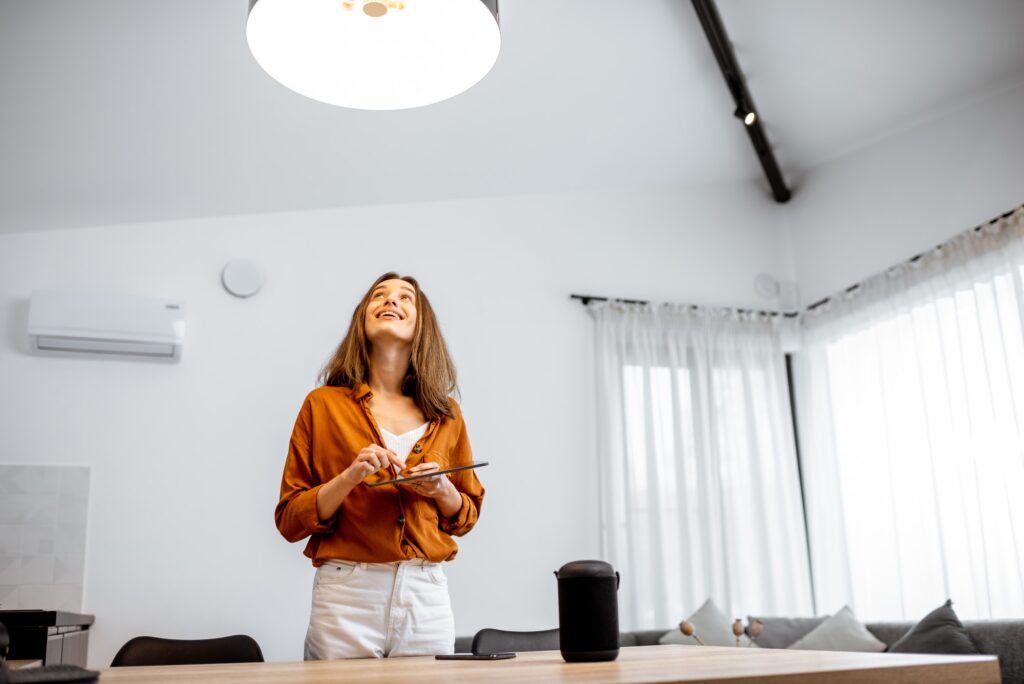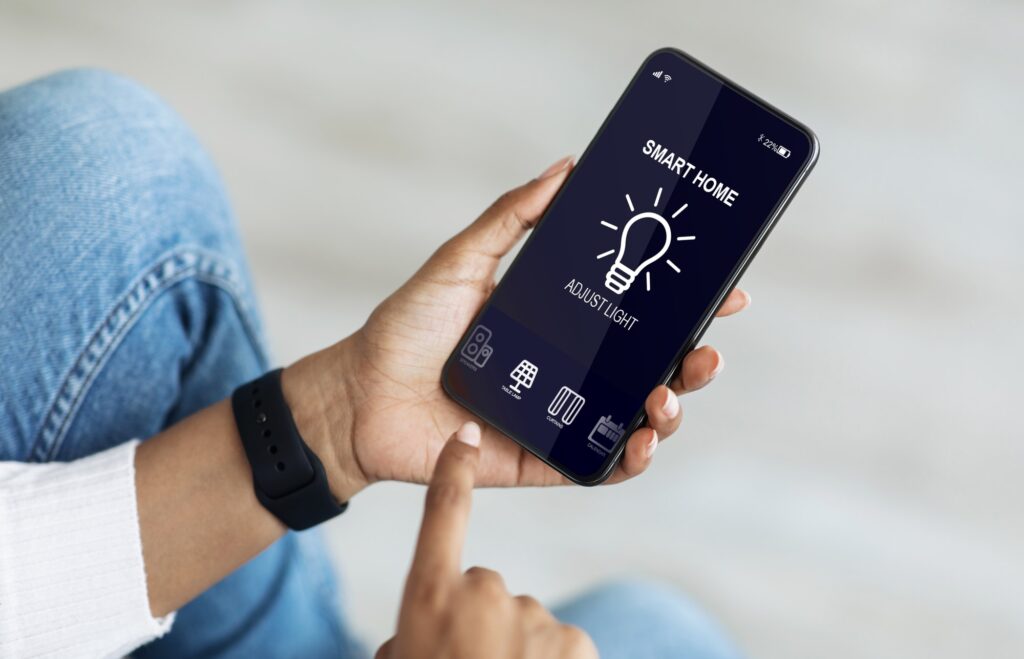In recent years, the integration of smart technology into our daily lives has transformed the way we interact with our homes. One significant advancement in this realm is the advent of smart lighting systems. In a world where technological innovation transforms the ordinary into the extraordinary, smart lighting stands out as a beacon of modernity, illuminating our spaces in ways we could once only imagine. These systems offer not only enhanced convenience but also energy efficiency and the ability to customize the ambiance of any space. In this guide, we’ll delve into the world of smart lighting, exploring its features, benefits, and the exciting possibilities it brings to modern living.
What is Smart Lighting?

Smart lighting refers to an advanced lighting system integrated with cutting-edge technologies that enable users to control and customize their lighting environment. Unlike traditional lighting, smart lighting goes beyond the simple on-off functionality. It typically involves the use of connected devices such as smart bulbs, switches, and controllers that can be remotely operated through mobile applications or voice commands. This technology allows users to adjust brightness levels, change color temperatures, and even create dynamic lighting scenarios. Smart lighting systems often offer features like automation, scheduling, and integration with other smart home devices, contributing not only to enhanced convenience but also to energy efficiency by providing precise control over lighting conditions in various spaces.
Key Features of Smart Lighting:
1. Remote Control:
Users can control their lights from anywhere with an internet connection, providing flexibility and security.
2. Customizable Ambiance:
Change the color and intensity of lights to create different moods or match specific activities, such as reading or relaxing.
3. Automation:
Set schedules for lights to turn on or off automatically, simulating occupancy and enhancing home security.
4. Voice Control:
Integration with virtual assistants like Amazon Alexa or Google Assistant allows users to control lights through voice commands.
5. Energy Efficiency:
Smart lighting systems often use energy-efficient LED bulbs and offer features like motion sensors to minimize unnecessary usage.
How Do Smart Lighting Systems Work?
Smart lighting systems operate through an intricate interplay of connected devices and innovative technologies. At the core of this technology are smart bulbs, switches, and controllers equipped with wireless communication capabilities, often utilizing Wi-Fi, Zigbee, or Z-Wave protocols. When integrated into a home network, these devices allow users to exert control remotely through dedicated mobile applications or voice commands. The communication between devices facilitates dynamic adjustments to brightness, color, and operational status. Users can orchestrate their lighting environment with precision, employing features such as scheduling, automation triggered by motion sensors, and the creation of customized scenes. The intelligence of smart lighting extends to seamless integration with popular voice assistants, turning verbal commands into instant lighting transformations. Whether it’s setting the mood for a movie night or optimizing energy efficiency through scheduled routines, smart lighting systems redefine our interaction with illumination, offering a blend of convenience, customization, and modern technology.
Types of Smart Lighting
Choosing the perfect smart lighting for your space requires a grasp of the diverse types available and aligning their features with your specific needs. Let’s explore the different types of smart lighting to help you make the perfect choice for your space.
1. Smart Bulbs:
Smart bulbs are a popular choice for those seeking versatility and ease of installation. These bulbs can change colors, adjust brightness, and often come with additional features like scheduling and remote control. Compatible with standard sockets, they are a convenient and flexible option. Whether you seek to create a vibrant, energetic atmosphere with diverse hues or prefer the warm embrace of adjustable white tones, these bulbs allow you to tailor the ambiance of your space effortlessly. Their energy-efficient LED technology not only illuminates with brilliance but also contributes to sustainable and cost-effective lighting solutions.
2. Smart Switches and Dimmers:
For those who want to retain their current light fixtures but still enjoy smart functionality, smart switches are the answer. These switches replace traditional ones and grant control over the connected lights. They allow users to operate existing lighting fixtures from anywhere via dedicated mobile apps or voice commands, providing a seamless integration of technology into daily routines. On the other hand, smart dimmers elevate the experience by enabling users to adjust brightness levels according to their preferences. This versatility not only enhances ambiance for various activities but also contributes to energy conservation.
3. Smart Light Strips:
Ideal for creative lighting solutions, smart light strips are flexible, adhesive strips that can be placed almost anywhere. These strips offer color-changing capabilities, allowing users to create vibrant, dynamic lighting effects. Perfect for accent lighting and adding a touch of flair to any space.
4. Smart Lighting Panels:
For those looking to make a bold visual statement, smart lighting panels offer a unique solution. These modular panels can be arranged in various configurations, providing both functional lighting and artistic expression. They are an excellent choice for those who want to merge technology with aesthetics.
5. Smart Ceiling Lights:
These fixtures are equipped with smart technology, allowing for adjustable brightness, color temperature, and sometimes even color, providing a comprehensive lighting solution for a room.
6. Smart Outdoor Lighting:
Extend the benefits of smart lighting to your outdoor areas with specialized solutions. Smart outdoor lights often come equipped with weather-resistant features and can be controlled remotely, providing both security and ambiance to your outdoor spaces.
Benefits of Smart Lighting
The adoption of smart lighting offers a myriad of benefits, transforming the way we illuminate and interact with our living spaces. Here are some key advantages:
1. Energy Efficiency:
Smart lighting often utilizes energy-efficient LED bulbs, reducing energy consumption compared to traditional incandescent bulbs. With features like motion sensors and automated scheduling, it minimizes unnecessary usage, reducing electricity bills and environmental impact.
2. Customization and Ambiance:
Smart bulbs with color-changing capabilities enable users to customize the color of the light, allowing for personalized atmospheres to suit different moods or occasions. Adjusting color temperatures provides flexibility, allowing users to create warm, cozy lighting or cool, invigorating environments.
3. Convenience:
The ability to control lighting remotely via smartphone apps or voice assistants brings unprecedented convenience. Whether adjusting lights from across the room or while away from home, accessibility is at your fingertips.
4. Automation and Smart Home Integration:
Smart lighting systems enable the creation of schedules, automating when lights turn on or off, contributing to energy savings. It can seamlessly integrate with other smart home devices, allowing for coordinated automation and enhanced connectivity.
5. Security Enhancement:
Integrated motion sensors can trigger lights to turn on when motion is detected, enhancing security and safety. Smart lighting systems can be programmed to simulate presence by turning lights on and off, deterring potential intruders when residents are away.
6. Health and Well-being:
Tunable white light can be adjusted to align with circadian rhythms, promoting better sleep and overall well-being. Some smart bulbs offer the ability to reduce blue light exposure in the evening, minimizing disruptions to sleep patterns.
Installation and Setup of Smart Lighting
1. Choose Your Smart Lighting Components:
Select the type of smart lighting components that best suit your needs, whether it’s smart bulbs, switches, light strips, or other fixtures.
2. Check Compatibility:
Ensure that the chosen smart lighting components are compatible with your existing fixtures, and if necessary, with each other. Check the communication protocol (Wi-Fi, Zigbee, or Z-Wave) and any specific requirements.
3. Acquire Necessary Equipment:
Purchase any additional equipment needed, such as a smart home hub or bridge if your devices use Zigbee or Z-Wave protocols.
4. Install Smart Bulbs:
If using smart bulbs, simply replace existing bulbs with the smart ones. Follow the manufacturer’s instructions for any additional steps, such as pairing with a mobile app.
5. Install Smart Switches:
For smart switches, turn off the power at the circuit breaker, replace the existing switch with the smart switch, and follow the manufacturer’s instructions for pairing and setup.
6. Install Other Smart Fixtures:
If you have other smart fixtures, such as light strips or panels, follow the manufacturer’s instructions for installation. This may involve mounting, connecting, and powering the fixtures.
7. Set Up Smart Hub:
If your devices require a smart home hub or bridge, follow the manufacturer’s instructions to set it up. This typically involves connecting it to your Wi-Fi network and configuring any necessary settings.
8. Download and Install Mobile Apps:
Download the mobile apps associated with your smart lighting components. These apps are essential for controlling and configuring your smart lights.
9. Pair Devices with the App:
Follow the app’s instructions to pair each smart lighting device with the app. This often involves scanning for devices and confirming the connection.
10. Configure Settings:
Adjust settings within the mobile app to customize your smart lighting experience. This may include creating schedules, setting scenes, or adjusting color and brightness levels.
11. Test and Troubleshoot:
Test each smart lighting component to ensure proper functionality. Troubleshoot any issues by referring to the manufacturer’s guidelines or online resources.
12. Integrate with Voice Assistants (Optional):
If desired, integrate your smart lighting system with voice assistants like Amazon Alexa, Google Assistant, or Apple HomeKit. Follow the specific instructions for each voice assistant.
By following these steps, you can successfully install and set up your smart lighting system, transforming your home into a more versatile and connected living space. Always refer to the manufacturer’s guidelines for specific details and troubleshooting tips.
As we conclude our exploration of smart lighting, it’s evident that it transcends mere brightness; it’s a transformative force. Its energy efficiency and customizable features redefine living spaces. From the simplicity of remote control to creating vibrant ambiance, smart lighting doesn’t just provide light—it shapes our experiences. It’s not merely modern; it’s a fundamental aspect of intelligent living. Smart lighting doesn’t just illuminate rooms; it crafts environments, blending artistry with efficiency. It serves as a canvas for personal expression, seamlessly integrating technology into our homes. Embrace the light of tomorrow and let smart lighting redefine the way you see, feel, and experience your living spaces.
